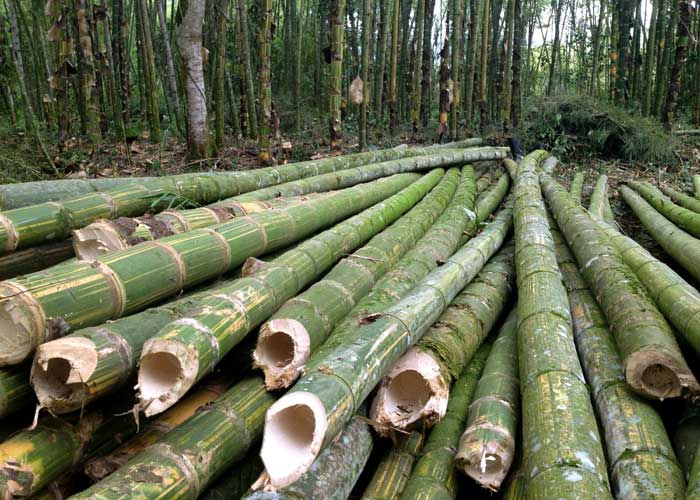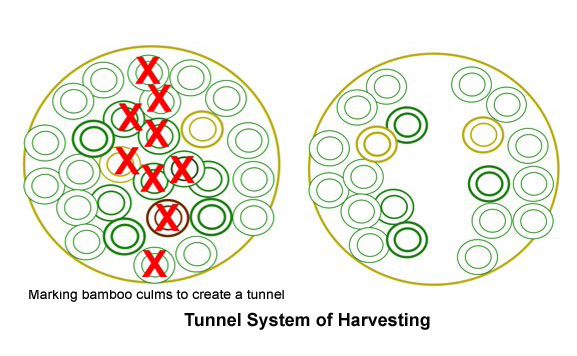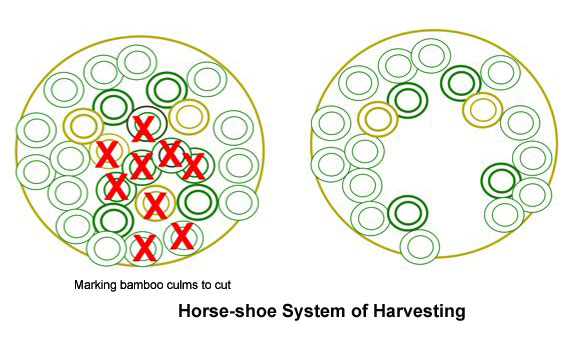Harvesting of bamboo depends on the cultivated species and is usually possible 4-6 years after establishing a plantation for commercial purposes. The plantation should be scientifically managed including fertilization, and management practices like pruning, thinning and weeding etc., For non-structural applications, and those that do not require their peak physical and mechanical properties, 2-3 years old culms from a mature clump may be harvested.
Culms should not be harvested in the growing season, normally during the monsoon months. Harvesting during this period could damage young and emerging shoots and retard the future growth of clumps. Some essential basic harvesting rules that should be followed in connection with managing bamboo strands are given below

- For timber production
- Dry season is the ideal time for harvesting unless control of congestion from the clumps is necessary.
- No clear felling should be done as it leads to their degeneration into a bushy form.
- All matured bamboo culms should be harvested (three years +).
- Current-year culms should be retained for reproduction. Similarly, a certain proportion of the older culms are to be retained to protect the new culms in order to ensure their proper growth.
- At least a minimum of six culms over one-year-old, spaced uniformly over the clump, should be retained. When there are large clumps, proportionately more mature culms can be retained.
- The number of harvestable culms should not exceed the number of poles that emerged in the last year.
- Harvesting of culms from clumps needs careful examination and culms should be felled/cut as low as possible leaving only one internode above the ground and a sharp knife or saw should be used when felling to avoid splitting and damage of culms.
- All dead and dry bamboo, as well as all debris as a result of harvesting and high cuts (due to lopping), should be removed from the clump.
- For edible shoots
- The shoots must be harvested at a height of 15–50 cm and depending on the species it may vary.
- Care should be taken without damaging the mother rhizome; soil surrounding the shoots may be removed and cut with a sharp and clean knife.
- Shoots having signs of diseases or deformity should be avoided and the few best/strongest shoot during the peak stage may be retained to grow into a new mother bamboo.
- Shoots from different locations of clumps may be allowed to grow rather than all shoots from one location to avoid congestion.
Uses of bamboo culms of different maturities
Bamboo culms have varied features of mechanical strength, moisture and starch content at different ages, and hence the harvesting age will be different depending on usage application. Basically, bamboo the culm consists of approximately 50% parenchyma tissue, 40% cellulose fibre and 10% vessels and fibres are very crucial to provide the strength of the bamboo culm and it is grouped with vessels.
As the bamboo culm grows older, the starch content becomes low and the lignin content gets enhanced which contributes to the hardness of the culm. Normally, it becomes strongest in its 3-4 years of age and becomes gradually brittle and weak, until it dies in its seventh or eighth year. In this stage, the cell wall will be highly lignified, and fragile due to a lack of elasticity. The starch and moisture contents become the lowest.
| # | Usage application | Harvesting age | Properties of culm |
|---|---|---|---|
| 1. | Edible shoots (Food) | 0–30 days (young shoots) |
Soft tissues like vegetables; water content of more than 90%. |
| 2. | Basketry and production of ropes | 0 – 1 year (juvenile) |
Slender internal tissues; culms immature; high starch and moisture Content. |
| 3. | Basketry, mats | 1 – 2 years (adult) |
High starch content; prone to decay and insect attack; High moisture content. |
| 4. | Furniture products and non-structural applications; paper and pulping | 2-3 years (late adult) |
The cell wall of fibre is slightly bigger; starch content comparatively lower; susceptible to decay and insect attack; comparatively lower moisture content. |
| 5. | Structural applications, industrial products | 3-4 years (old age) |
High structural stability; optimal cell wall fibres; starch and moisture content lower. |
Culm age
The culm age can be identified based on certain features of the culm sheath, development of branches and leaves, external colour of the culm, position of new culms, and so on. New culms are found on the periphery of the clump and the mature bamboo poles in sympodial bamboo clumps are commonly found at the inner core of the bamboo clump. Culm sheaths are usually absent on older culms. The accuracy of such a distinction, however, depends on the skill and experience of the person and is not always reliable. Therefore, other guaranteed methods have to be adopted to determine the age of bamboo. Age can also be determined by the following methods:
- Marking the culms with different colour paints
- Writing the year and month of shoot emergence using colour/paint
- Inscribing the year of shoot emergence.
Maturity marking
For the identification of mature culms for harvesting, three different colour paints are required, one for each year of a five-year cycle. It should be noted that culms that are older than 3–4 years should be logged, as they become weak and brittle and may be expected to die. After the culms attain full height during the first year, they are marked with paint.
A set of different colour paints are required; four colours one for each year of a four-year cycle. The first year of establishment is done with red colour, second year a yellow and third a blue and fourth year a black colour paint is recommended. The cycle may be repeated. Since by the fourth year the first year's culms will be harvested, the colours can be repeated in the fifth year culms.
Harvesting season
After the rainy season or the early dry season is the best time to harvest bamboo poles. The best time of the year to harvest culms is in the post-monsoon season, extending through the winter and culms can be harvested before sunrise. Harvesting bamboos during the summer to rainy period gets destroyed more rapidly than those felled in autumn and winter.
Methods of Harvesting
The species tend to have closely spaced culms in the clump may be necessary to resort to the ‘tunnel’ or ‘horse-shoe’ system of extraction/harvesting (eg.Bambusa bambos, Bambusa balcooa, and Dendrocalamus strictus.
The Tunnel System of Harvesting
In this method, a tunnel is created by making a 60-cm-wide path from one end of the clump to the other. The tunnels provide access to the inside of the clump and allow the easy working of the clump. It is also useful to remove weak and stunted culms from the periphery of the clump, retaining only the healthy ones.

The Horseshoe System of Harvesting
The clump is worked in a horseshoe pattern, or the shape of an inverted V, by making an opening opposite the densest concentration of culms. All the old, dry, and rotten culms are extracted and leaving only 1-year-old vigorously growing culms, along with an appropriate number of evenly spaced and healthy older culms. This method of extraction is costly but completely removes mature and immature culms. They prevent congestion, provide space for proper growth of shoots and culms, and ensure the easy working of the clump in subsequent years. Bamboo culms can be cut down in a slanting manner just above the lowermost nodes to minimize wastage, avoid sprouting and prevent rainwater from stagnating in the cavity of the stump portion.

Stacking and storage of harvested bamboo culms
The harvested culms should be properly stalked vertically and stored for a certain period for seasoning. Vertical stalking facilitates uniform and quicker drying. Avoid horizontal stalking as far as possible as it puts pressure on culms at the bottom of the pile and may cause injury or deformity. The stalked area should be covered or shaded on concrete or cement flooring; if it is not possible, a tarpaulin or polythene sheet should be spread at the bottom to reduce vulnerability to termites and borer pests. Direct exposure to sunlight may cause rapid drying, resulting in splits and cracks.
Yield
The yield of bamboo plantations is highly dependent on the management practices, site conditions, quality of the planting materials etc., and it also varies from species to species. A well-managed mature plantation can yield 25-30 tonnes of culms per hectare; 5–6 culms per clump of medium diameter bamboo can be obtained, i.e. 2500–3000 culms per hectare.
The yield of Bambusa tulda, in the unmanaged natural forest patches in Assam, is reported as 12.5 tonnes (dry) per ha on a four-year cycle. In villages, it goes to 20-23 t ha-1. In scientifically well-managed plantations, the annual yield of species like B. bambos, B. balcooa, B. nutans, D. strictus etc., varies from 25 to 40 t ha-1. In the case of Dendrocalamus brandisii, at 6 x 6 m spacing around 278 bamboo plants can be accommodated per ha and the harvestable yield varies from an average of 2 culms/clump from third onwards. From eight years up to forty years, an average of 10 or more culms/clumps may be expected.
In the case of D. stocksii, 10 culms/clump in the fourth year and around 15 culms/clump may be expected from the fifth year onwards with a spacing of 4 x 4 m (625 plants/ ha). The yield on Guadua augustifolia from Coorg, Karnataka shows that an average of 12 extractable culms per year from the fourth year with a total of 4320 culms may be expected per ha.
